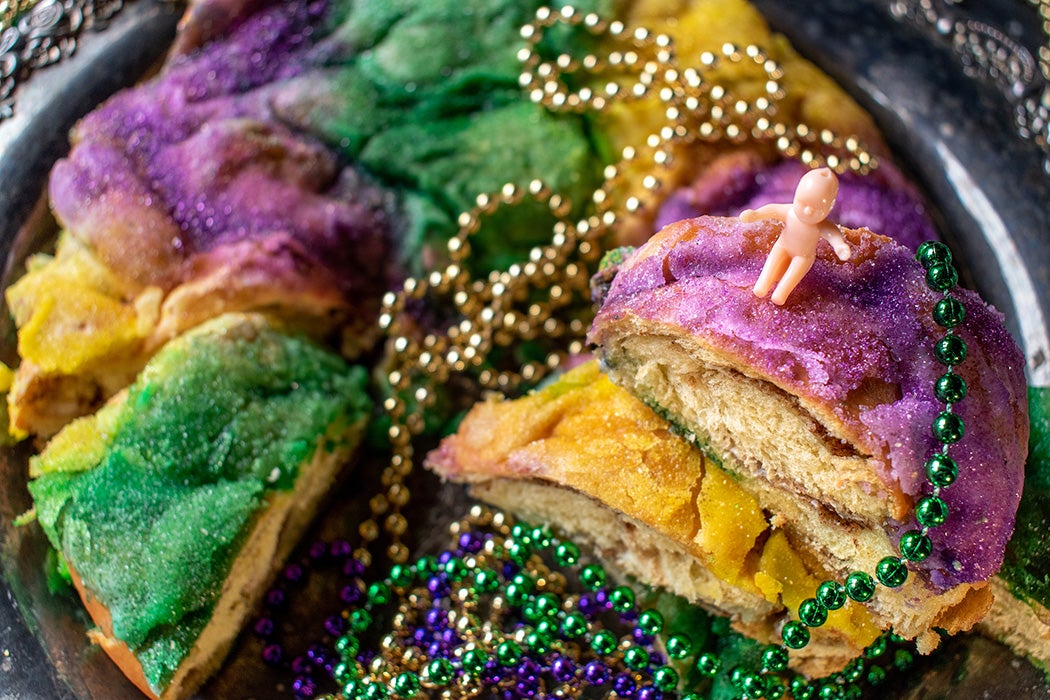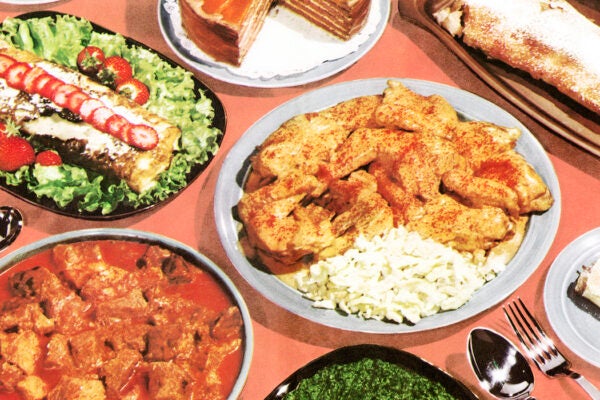Carnival season starts in early January, on Epiphany, and ends in mid-February, on Mardi Gras, the day before Lent. In New Orleans, carnival season and Mardi Gras feature parades with high-school marching bands and floats from which masked celebrants throw plastic-colored beads, commemorative cups, parade-themed doubloons (large Mardi Gras-colored plastic coins), and trinkets, to name a few treasured objects and participants. The parades wind throughout the city streets; everyone is welcome.
Carnival season celebrants across New Orleans—at work, school, and home—also throw king cake parties centered on the consumption of a ring-shaped pastry covered in icing and topped with purple, green, and gold sugar. Inside the cake hides a tiny, plastic baby. The person who finds the baby in their bite is responsible for bringing a king cake to the next party. But despite the numerous king cakes being carried and devoured around the city, few seem to know about the cake’s history.
King cake parties became popular with Carnival season elites during the Reconstruction Era, write scholars Anthony J. Stanonis and Rachel Wallace, when political enclaves of white supremacist activists revolted against the new American South. As they note,
Emancipation and civil rights legislation after the Civil War challenged white supremacy, and the defeated Confederates responded with violence, most notoriously in a massacre of Black political activists at a New Orleans rally in 1866.
Leagues of white supremacists organized to overthrow the state government and suppress Black voters. Not coincidentally, “[t]he appearance of vigilante political organizations of armed former Confederates coincided with the proliferation of exclusive and secretive Carnival-oriented groups.”
Rocky L. Sexton notes that part of the celebration is a compilation of centuries-old symbolic food and colors that represent memories of past events. The plastic baby serves as a reminder of the birth of Jesus Christ, for instance. The colored sugar sprinkled on the cakes, however, harks back to the values of early, white, business-class celebrants of the Rex Krewe, a popular Carnival group in New Orleans. The colors each have a mission and vision born out of the krewe: green represents faith; purple represents justice; and gold represents power.
Today, as schools in New Orleans, including Robert E. Lee Elementary, are changing their names to rectify the past, and Confederate statues are torn down throughout the American South, should we consider the king cake’s history as a lesson in critical race theory?
Critical race theory is an analytical lens that highlights the workings of structural racism, growing generally out the 1960s Civil Rights movement and specifically out of the study of civil rights legislation in the 1970s and 1980s. This narrow definition notwithstanding, scholars Anthony L. Brown and Keffrelyn D. Brown, who integrate critical race theory when analyzing K-12 textbooks in Texas, voice their concerns that “traditional curriculum glosses over events, over-generalize and/or exclude different group experiences.”
At present, the history of king cake isn’t taught at K-12 schools in New Orleans even though the cake’s appearance and consumption symbolize an era that epitomized white supremacy. Ostensibly, if young students learn about the Civil War, the Reconstruction Era, and the 1960s Civil Rights movement, they would also learn about the white supremacists who were willing to maintain their positions of privilege through wielding violence towards Black people supported by exclusive organizations.
Weekly Newsletter
In 2023, celebrants may be hard pressed to stop following the traditions of Carnival and Mardi Gras, however, because memorialization plays a major role for those who attend king cake parties. As Stanonis and Wallace remind us,
The king cake reigns among today’s New Orleanians. In a city that has embraced its customs and history with vigor in the aftermath of Hurricane Katrina, the king cake has come to embody New Orleans culture: tradition, family, revelry, and devotion.
In the aftermath of disaster, Mardi Gras represents the city’s durability and resilience. But as geographers Rebecca Sheehan, Jordan Brasher, and Jennifer Speights-Binet also point out,
the problem of memorialization in the US South has often been one of stasis dedicated to white supremacist males, where memorialization is generally not only set materially in the landscape…but also in terms of the overlapping discourse and practices associated with such memorialization.
The ubiquity of king cakes—like other Mardi Gras traditions—exemplifies this stasis. But Sheehan, Brasher, and Speights-Binet suggest that regenerative memorialization may shift these engrained memory practices. Memory work that focuses on
the networks associated with people, ideas, materials, capital, and development that constitute memorial landscapes – and the reparative and self-healing possibilities of those landscapes as part of constantly evolving sociocultural systems…[A]ddressing entrenched wounds, regenerative memorialization can help chart paths toward a more socio-spatially just future for the American South.
What would such memory work look like for K-12 students? It may start with the textbook. Brown and Brown demonstrate that “historic acts of racial violence toward African Americans receives minimal and/or distorted attention in most K-12 texts.” They conclude their study with both optimism and disenchantment, “knowing that longstanding efforts to reform the school curriculum…is indeed reflected in today’s school text, [but] much more change needs to occur in the K-12 curriculum.”
Support JSTOR Daily! Join our new membership program on Patreon today.







